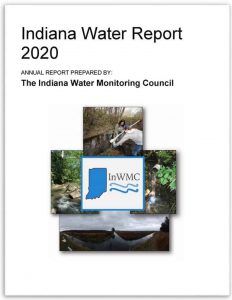Largely behind the scenes, the various agencies of Indiana’s state government including the Indiana Department of Environmental Management, the Indiana Department of Natural Resources, the Indiana State Department of Agriculture, and the Indiana State Department of Health, conduct many ongoing and special projects from year to year to protect our statewide surface and groundwater resources.
These assessments, studies, and monitoring efforts are critical to all areas of our life from our food supply to recreation activities to our economic capacities. The latest Indiana Water Report from the Indiana Water Monitoring Council goes in depth with each agency’s efforts during 2020.
The projects listed below are just a sample of some of the activities taking place. For more detail on these and other projects download the full 2020 Indiana Water Report.
Indiana Department of Environmental Management (IDEM)
Groundwater Monitoring Network
In response to the large percentage of Hoosiers that drink residential well water not regulated by the Safe Drinking Water Act, IDEM’s Drinking Water Branch manages a statewide Groundwater Monitoring Network to evaluate groundwater quality in private water systems and noncommunity public water systems across the state. View results and the 2016 Groundwater Monitoring Network Report at www.in.gov/idem/cleanwater/information-about/groundwater-monitoring-and-source-water-protection/statewide-groundwater-monitoring-network/.
PFAS Sampling
Starting in 2021, the IDEM’s Drinking Water Branch in partnership with the Indiana Department of Health will begin sampling for per- and polyfluoroalkyl substances (PFAS) in community public drinking water systems. Sampling will begin with small communities with populations less than 10,000 whose systems were not already sampled as part of the U.S. EPA’s Unregulated Contaminant Monitoring Rule. For more information on the sampling program visit: www.in.gov/idem/resources/nonrule-policies/per-and-polyfluoroalkyl-substances-pfas/.
Other PFAS monitoring efforts in the state include grant funding from the Great Lakes Restoration Initiative to collect fish from sites in the Great Lakes Basins for analysis of PFAS. For more information on this project contact Cyndi Wagner at cwagner@idem.in.gov.
White River Mainstem Project
Through the collaborative efforts of IDEM, the Indiana Department of Natural Resources, and the Muncie Sanitary District’s Bureau of Water Quality, water sampling was undertaken in 2020 to provide a comprehensive assessment of the ability of the mainstem White River to support aquatic life use with particular emphasis on fish communities. Results are expected soon on the project’s Story Map at www.storymaps.arcgis.com/stories/3329a43505094393b573f0788e1933d7.
Indiana Department of Natural Resources (IDNR)
Volunteer Monitoring Program
The Voluntary Monitoring Program (VMP) is a cooperative effort between the IDNR, the United States Geological Survey, private land-owners, and public water utilities (volunteers) to monitor and record depth to groundwater levels from water monitoring wells across the state. The public can view data for these sampling sites including graphs of the data over time at www.groundwaterwatch.usgs.gov/netmapT4L1.asp?ncd=IDV.
Drought / Water Shortages
Each month IDNR’s Division of Water posts a summary of key parameters used to predict/monitor drought conditions in the nine climate divisions of Indiana. The report includes data from a variety of sources including the National Oceanic and Atmospheric Administration, the Midwestern Regional Climate Center, and the Indiana State Climate Office. The latest report can be found at www.in.gov/dnr/water/water-availability-use-rights/water-resource-updates/monthly-water-resource-summary/.
Additionally, IDNR announced plans to update the Indiana Water Shortage Plan in 2021 – a plan which includes triggers to identify the start of a water shortage and appropriate responses, including water-use priorities and conservation tools. More information on the current Indiana Water Shortage Plan can be found at www.in.gov/dnr/water/water-availability-use-rights/indianas-water-shortage-plan/.
Central Indiana Water Study
The Indiana Finance Authority, INTERA Geoscience and Engineering Solutions, the United States Geological Survey, the Indiana Department of Natural Resources, the Indiana Geological and Water Survey, and Empower Results, continued evaluating current water resources availability and future demands in Central Indiana as part of the Central Indiana Water Study. The study is assessing current and projected water resources, identifying data gaps, and upgrading surface and groundwater monitoring networks. Results are expected this summer. More information can be found at www.in.gov/ifa/regional-water-studies/central-indiana-water-study/.
Indiana State Department of Agriculture (ISDA)
Commitment to Water Quality Story Maps
The ISDA has developed Story Maps for the major river and lake basins in Indiana to showcase the efforts to enhance water quality as well as educate landowners (both rural and urban) about: local, state, and federal cost-share programs; educational opportunities; and rural and urban conservation practices. Each Story Map contains information about the watershed’s efforts to reduce nutrient runoff including watershed quality, water monitoring locations, local conservation groups and more. Information about the program along with links to the Story Maps can be found at www.in.gov/isda/divisions/soil-conservation/indiana-state-nutrient-reduction-strategy/.
Indiana State Department of Health (IDOH)
IDOH’s Environmental Public Health Division (EPH) collaborates on various projects with partners across the state to improve health outcomes and minimize risk to Hoosiers. Programs operated by the EPH are concerned with a mix of surface and groundwater. The EPH also provides direct assistance to local and county health officials, onsite sewage system construction permitting, beach water quality surveillance at regulated facilities, and direct private well-water outreach programs for communities. More information about these programs can be found at www.eph.in.gov.
Many thanks to the Indiana Water Monitoring Council for their great work in assembling the 2020 report! Read more about these water monitoring and research projects and others happening throughout the state in the full report.
Who is the Indiana Water Monitoring Council?
The Indiana Water Monitoring Council (InWMC) is a non-profit association founded in 2008 as a broad-based, state-wide body committed to enhancing the communication, collaboration and coordination of professionals, organizations, and individuals involved in monitoring Indiana’s water resources, including ground and surface waters, their physical, chemical and biological components, and associated wetland resources.

